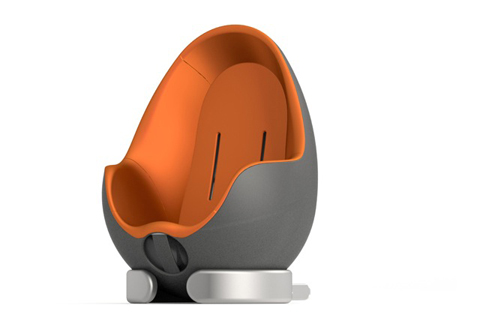
Several people have sent in tips from all over for the Nestt car seat concept by Chicago-based industrial design firm think/thing. In fact, one of the architect designers emailed me a couple of weeks ago, interested in my thoughts on it.
What with the new kid and all, my turnaround time is lagging. And besides, I'm in purely practical mode at the moment, and considering the pure concept stage of the Nestt, which is years and years and countless iterations away from ever seeing the backside of a real kid, I just couldn't get motivated.
If the rendering looks sexy, it's because it's missing the minor details that a real car seat would need: safety straps. infant support inserts. giant instruction and disclaimer stickers. sippy cup holders.
I don't want to sandbag a well-meaning and ambitious set of visionaries, if that's what think/thing are, or but a damper on their pursuit. As a visioning exercise meant to tackle some of the most annoying and unattractive products in the kids market, the Nestt is a welcome diversion. But so far, beyond making a strong aesthetic presence, it breaks no new ground, and there are flawed or unresolved assumptions that'll need to be addressed if the firm wants to use this as anything more than a calling card.
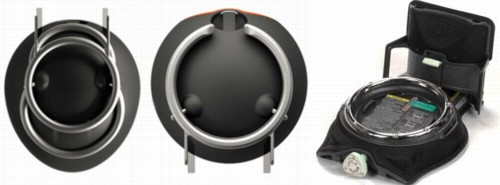
The rotating attachment mechanism looks slick and may be on par with a regular click-in plastic base, but it's seriously underrealized compared to the Orbit system: Three springloaded screws vs a 360-degree interlocking steel ring and an "aircraft aluminum backbone." Orbit's metal-on-metal ka-chung is the experience design equivalent of a Lexus door closing. Whatever its actual safety performance, the Orbit base signals over-engineered safety in a way that the Nestt's pared down trivet-and-screws base does not.
The internal steel safety cage is a great concept, but the structure visible through the translucent shell [a nice idea, btw; I saw a translucent car seat in Amsterdam by Koelstra, wonder whatever happened to that thing?] looks entirely non-performing. I'd expect a structure like that to derive from a race car cage, or another kind of rigorously tested seat that's been through countless dynamic force simulations. This one looks like a line drawing placeholder. The Radian car seat's no looker, but the shape of its metal frame is derived from airplane seats and auto seats and a great deal of actual testing.
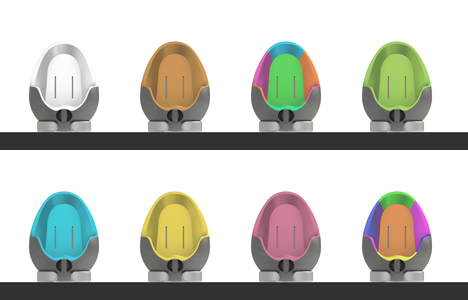
The egg shape is cool-looking. [Besides the Orbit, the customer for egg-shaped car seats has the Bebe-Confort Creatis as well (below), though it's only a 0-13kg infant carrier. Bebe-Confort also makes a pivoting car seat.] The idea of a roof on a car seat is pure folly that betrays a triumph of design over actual use. Even if your kid doesn't happen to grow out of it too quickly, though, the Nestt is a single-purpose device: it'll be too heavy and awkward for a plane, and there's no mention of a stroller. So urban parents and travelers are SOL.
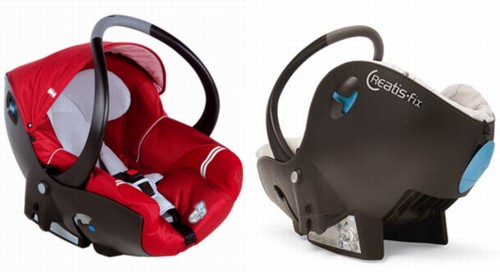
Nestt is supposed to be "the best car seat in the world." Yet it seems to confuse the world with the US. It touts its side impact protection and its compliance with US federal safety standards--which have no provision for side impact protection. Why not design to EU standards, or Japanese standards, something more rigorous than US standards?
The last piece of the puzzle is, or should be the first. It's always possible to create the best of anything, if cost or actual marketability are no concern. As it stands right now, the Nestt is to car seats what the $17,000 Vertu is to cell phones: mid-level technology wrapped in an hyper-stylized, cost-no-object skin .
There are $1200 car seats in Japan--they're incredibly well built, great fabric and finish, as well as being super-secure cocoons. And people regularly shell out $300 for top-of-the-line Maxi-Cosi's in Europe. [Some knuckleheads even spend another $100 to ship the things to the US.]
But the US car seat market is dominated by cheap, ugly crap that drags down the market for high-end, high-performance car seats. [When Maxi-Cosi made their long-awaited entry to the US market, they did it with a downgraded, value engineered, tackified version of their EU products. US Maxi-Cosis use lower grade plastic; the Priori base was stripped and chopped in half; the Mico has a crappy, bulky canopy instead of the EU's hidden nylon version. Rather than be the best in the market, they settled on being slightly better than the rest.] I mention this because even if it were a fully resolved product, the market opportunity for the Nestt is going to be pretty small.
But the Nestt is a concept, not a product. If it were a sketch on a napkin, genpop's expectations would be better calibrated, but sexy renderings which are happily published and consumed by the insatiable, all-eye-candy, no-context designweb can sometimes seduce architects and designers into thinking their work is done. I'm sure the big thinkers at think/thing are not so easily misled.
So yeah, hope that's not a sandbagging. Keep me posted.
Nestt Car Seat at think/thing: don't miss the video [thinkthing.net via everywhere]

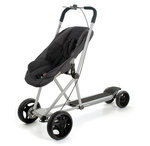
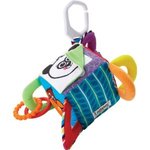
Where can you get information about the actual US car seat standards? I have found infomation about the european standards but cant find specifics about US standards. I know that there is a side vs. front impact difference although what is the MPH difference of the front impact.
thanks
[it's FMVSS 213, put out by the NHTSA, which means Federal Motor Vehicle Safety Standards part 213, Child Restraint Systems, overseen by the National Highway Transportation Safety Administration. Infant carriers are also regulated--but just barely, and quite poorly--for non-car use by the Consumer Products Safety Commission. -ed.]
Speaking as a current designer and a former automotive engineer, I'd rather have engineers designing my kid's car seat than designers (or architects).
"But the US car seat market is dominated by cheap, ugly crap that drags down the market for high-end, high-performance car seats."
I've often wondered why EVERYONE isn't rolling a Bugaboo and a $1200 Japanese car seat.
Probably because that's an incredible amount of wasted capital. Even if you've got the money -- and normal people do not -- it's better spent elsewhere.
[another good way to say it, yeah. If $50-100 carseats do the job, is there a 'need' for a $500 model just because there's a population that could hypothetically afford it? -ed.]
I haven't seen the North American Maxi-cosi in person, only in photos, yet I agree that it doesn't look nearly as nice as the original. However, the European Maxi-cosi infant seats (like many other brands there) have only 3-point harnesses. As well, their forward-facing 'toddler' seats (Group 1) are rated from 9 months up. I was glad we brought our ugly Graco along with us when my brother-in-law picked us up with a forward-facing seat when our son was just 9 months and a few days.
The one thing I really liked about the German infant seats were the 'wedges' that fit under a newborn to keep the baby in a flatter position. As we only ever used our Canadian Graco and Britax seats in Europe, I've no experience except seeing the carseats our newborn nephew used.
I don't know all the standards details, except that carseats used in Canada must be certified by Transport Canada, but after living in Europe and curiously comparing lots of baby products (and seeing many many infant seats in the front passenger seat), I'm no longer convinced EU standards are better than ours. Which is why I scoffed at the Lufthansa flight attendant who questioned the use of our Britax Marathon...
Excellent review. We all agree this is a beautiful car seat. Your review brings us down to earth.
I haven't seen the Euro version to compare, but my complain with the canopy on the Mico is that it doesn't cover very much. I often have to do some creative carrying to keep the sun out of my son's eyes.
Otherwise, I think it is great.
There are only two color schemes I could go for...
The Mork -- pure white.
The Cadbury* -- brown outside, creamy yellow and white inside.
*Only if the seat doesn't get smaller each year.
[nanoo nanoo on that. -ed.]
Interesting your comment regarding the $1200 Japanese car seat. Of course, only 5 people in the whole country are USING car seats... I've lived in Japan for a total of 9 years, and virtually no one uses car seats for children or infants. Kids crawling all over the cars, babies in arms, etc. Culturally it's accepted and the "laws" have no penalties. So, despite the fact that they sell them, if you drive around the average Japanese suburb, it is extremely rare to actually find anyone using a car seat at all. So, in the long run, I'll probably take the cheap american crap that gets used over no car seat all. I, however, own a Britax Marathon for my now-2-year-old. And haul it through the airport to use on the plane, too!
The Nestt is also a full functional escape pod which can be ejected from the car in case of an emergency. It does cost extra to have Snake Plissken find and rescue the child.
Your theme is dead-on here. Nice graphics, but where's the real prototype?
But then what's the deal with all the potshots? Don't we *want* more options for well-designed baby equipment? You seem to think we've won the war already. But what kind of market share do you think Orbit has vs. Britax and Graco? And it's not like a Britax is cheap.
It's far too early to be discouraging good design.
Examples of potshots:
- No cup holder? I have a feeling these guys can handle designing a slick cup holder.
- It needs to look like it was designed to withstand impacts? Last I looked, my car had sexy bodywork, not a bunch of exposed steel beams.
- Too heavy for the airplane? And the Britax is light and easy?
- Mid-level technology? You mean a proper respect for the balance of form, function, and *price*? I don't think these guys are trying to build a Ferrari for the few.
Yes, show us something real "think/thing", it's too easy to just make pretty pictures. But don't stop trying to build a well-designed seat for the masses.
[If there's a single worst offender in the system right now, it's probably Britax: they're heavy, expensive, only marginally better than minimum in terms of safety AND they're ugly. If the Nestt went into production tomorrow, it'd be the same, only hotlooking. And that's not enough to be "best in the world" in my view. I only mention Orbitz so prominently because they're the farthest along on fundamentally rethinking the car seat system. And because their infant seat looks like an egg, too. Or at least an egg cup.
But I don't see why questioning assumptions or critiquing an early, published design has to be dismissed as just "potshots." I'm all for innovation and experimentation and pushing good design forward; I don't think the endless circle jerking of dozens of surface-obsessed design blogs is necessarily the most effective way to bring it about. It may work for posters and owl-printed tea cozies, but not for car seats. -ed.]
Sorta reminds me of Mork's pod from the 80's tv series "Mork & Mindy"!
Where can I buy it in Europe?
thanks, me
I want to know where i can find this car seat in California , and what is the price
ME too!